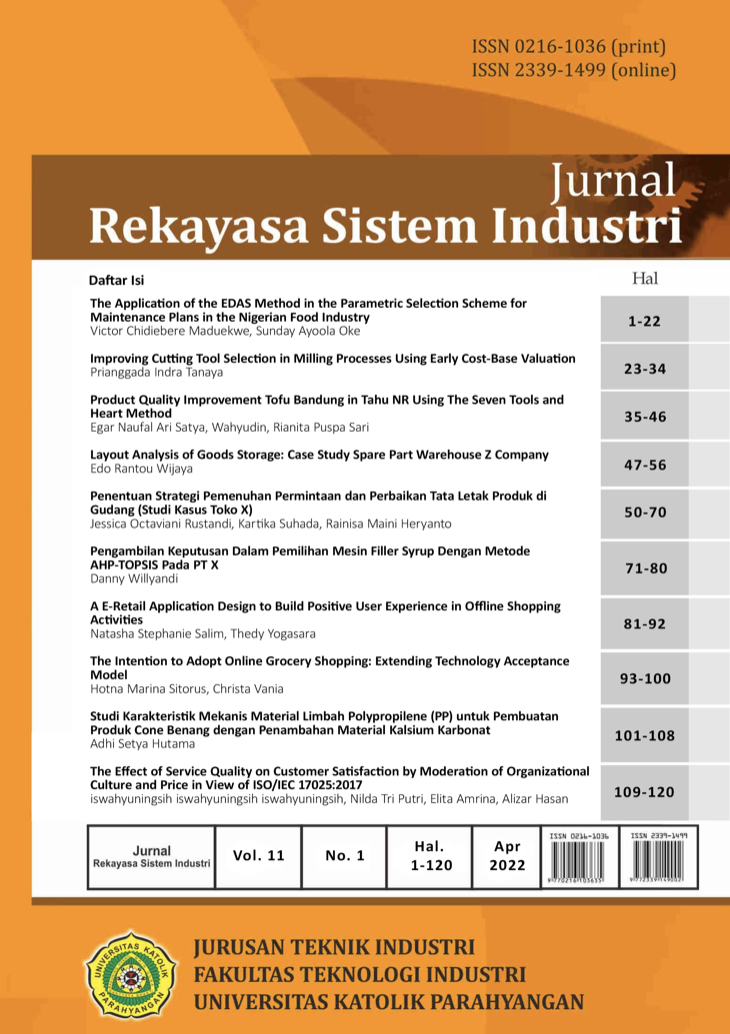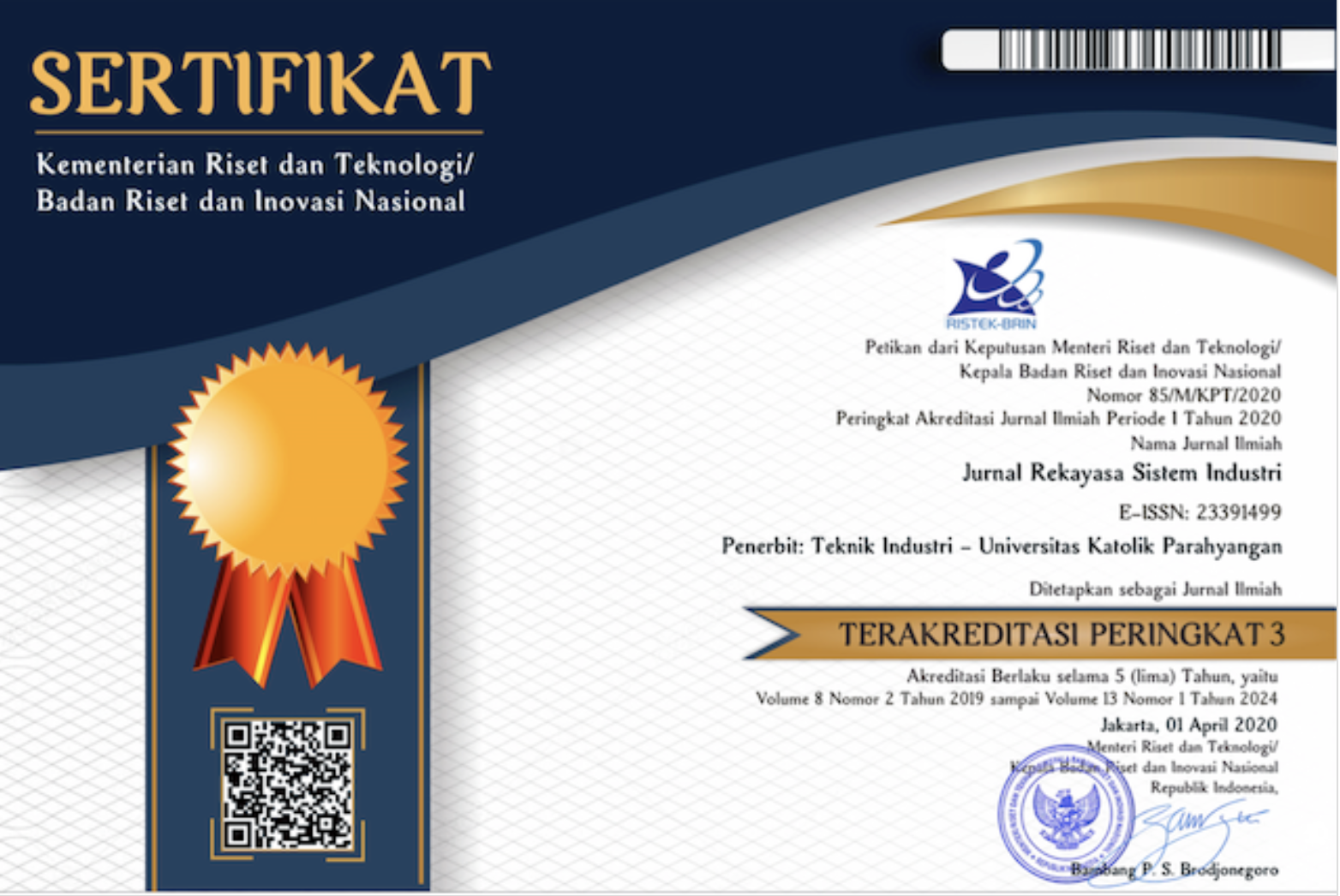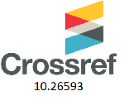The Application of the EDAS Method in the Parametric Selection Scheme for Maintenance Plans in the Nigerian Food Industry
DOI:
https://doi.org/10.26593/jrsi.v11i1.4349.1-22Kata Kunci:
maintenance analysis, availability, EDAS, food industry, maintenance planningAbstrak
Nowadays, maintenance performance in organizations has become compelling due to competitiveness in the global market and the inclusion of more legislation issues (such as safety and health regulations) in assessments. In this article, the purpose is to formulate in maintenance problem for a food processing unit as a multicriteria problem and solve it using the evaluation based on distance from the average solution (EDAS) method. To attain this purpose, the authors defined a set of weighted criteria and a set of alternatives, and the solution is the alternative that scores the best in those criteria. Consequently, analysis was done based on the EDAS method and the calculated results from the literature data. Consequently, the parameters considered include the frequency of failure, MTBF, MTTF and MTTR while availability is the response. The EDAS method was used to select the best alternative (MTTR, 0.8802) and this score of 0.8802 is for an alternative. The chief novelty of this article is the unique introduction of an innovative EDAS method, which requires only two measures of the desirability of alternative (positive and negative distances from the average solution) but excluded the evaluation of the idea and nadir solutions for the key performance indicators of maintenance. Consequently, this study initiates a maintenance plan for the food industry referring to the key performance indicators as a cause for poor availability of equipment in the Nigerian food industry.
Referensi
Aarnisalo, K., Tallavaara, K., Wirtanen, G., Maijala, R., & Raaska, L. (2006). The hygienic working practices of maintenance personnel and equipment hygiene in the Finnish food industry, Food Control, 17(12), 1001-1011.
Adebiyi, K. A., Ojediran, J.O., & Oyenuga, O.A. (2004). An appraisal of maintenance practice in food industries in Nigeria, Journal of Food Engineering, 62(2), 131-133.
Aggarwal, A., Choudhary, C., & Mehrotra, D. (2018). Evaluation of smartphones in Indian market using EDAS, Procedia Computer Science, 132, 236–243.
Amrina, E., Kamil. I., & Aridharma. D. (2020). Fuzzy multicriteria approach for sustainable maintenance performance evaluation in cement industry, Procedia Manufacturing, 43, 674-681.
Aremu, O.O., Cody, R.A., Hyland-Wood, D., & McAree, P.R. (2020). A relative entropy based feature selection framework for asset data in predictive maintenance, Computers & Industrial Engineering, 145, 106536.
Asante, D., He, Z., Adjei, N.O., & Asante, B. (2020). Exploring the barriers to renewable energy adoption utilising MULTIMOORA-EDAS method, Energy Policy, 142, Article 111479.
Asioli, D., Aschemann-Witzel, J., Caputo, V., Vecchio, R., Annunziata, A., Næs, T., & Varela, P. (2017). Making sense of the “clean label” trends: A review of consumer food choice behavior and discussion of industry implications, Food Research International, 99(1), 58-71.
Bader, F. & Rahimifard, S. (2020). A methodology for the selection of industrial robots in food handling, Innovative Food Science & Emerging Technologies, 64, August 2020, 102379. https://doi.org/10.1016/j.ifset.2020.102379.
Behzad, M., Zolfani S.H., Pamucar D., & Behzad M. (2020). A comparative assessment of solid waste management performance in the Nordic countries based on BWM-EDAS, Journal of Cleaner Production, 266, Article 122008.
Branská, L., Pecinová, Z., Paták, M., Staňková, M., & Kholová, P. (2016). Maintenance management systems in the Czech enterprises of chemical and food industries, Trends Economics and Management, 27(3), 20–29, DOI: http://dx.doi.org/10.13164/trends.2016.27.20.
Chemat, F. & Hoarau, N. (2004). Hazard analysis and critical control point (HACCP) for an ultrasound food processing operation, Ultrasonics Sonochemistry, 11(3–4), 257-260.
Coria, V.H., Maximov, S., Rivas-Dávalos, F., Melchor, C.L., & Guardado, J.L. (2015). Analytical method for optimization of maintenance policy based on available system failure data, Reliability Engineering & System Safety, 135, 55-63.
Darko, A.P. & Liang, D. (2020). Some q-rung orthopair fuzzy Hamacher aggregation operators and their application to multiple attribute group decision making with modified EDAS method, Engineering Applications of Artificial Intelligence, 87, Article 103259.
Dutoit, C., Dehombreux, P., & Lorphèvre, E.R., (2018). Using quality control in optimizing opportunistic maintenance, IFAC-PapersOnLine, 51(24), 643-648.
Dzwolak, W. (2019). Assessment of HACCP plans in standardized food safety management systems – The case of small-sized Polish food businesses, Food Control, 106, 106716.
Ecer, F. (2017). Third‐party Logistics (3PLs) provider selection via fuzzy AHP and EDAS integrated model. Technological and Economic Development of Economy, 24, 615– 634. https://doi.org/10.3846/20294913.2016.1213207.
Fan, D., Ren, Y., Feng, Q., Zhu, B., & Wang, Z. (2019). A hybrid heuristic optimization of maintenance routing and scheduling for offshore wind farms, Journal of Loss Prevention in the Process Industries, 62, Article 103949.
Fernando, N., Florentine, S.K., Naiker, M., Panozzo, J., & Chauhan, B.S. (2019). Annual ryegrass (Lolium rigidumgaud) competition altered wheat grain quality: A study under elevated atmospheric CO2 levels and drought conditions, Food Chemistry, 276, 285-290. https://doi.org/10.1016/j.foodchem.2018.09.145.
Fernandes, M., Canito, A., Bolón-Canedo, V., Conceição, L., Praça, I., & Marreiros, G. (2019). Data analysis and feature selection for predictive maintenance: A case-study in the metallurgic industry, International Journal of Information Management, 46, 252-262.
Fumagalli, L., Macchi, M., & Rapaccini, M. (2009). Computerized maintenance management systems in SMEs: A survey in Italy and some remarks for the implementation of condition based maintenance, IFAC Proceedings Volumes, 42(4), 1615-1619.
Gerbec, M. & Kontić, B. (2017). Safety related key performance indicators for securing long-term business development – A case study, Safety Science, 98, 77-88.
Gonzalez, E., Nanos, E.M., Seyr, H., Valldecabres, L., Yürüşen, N.Y., Smolka, U., Muskulus, M., & Melero, J.J. (2017). Key performance indicators for wind farm operation and maintenance, Energy Procedia, 137, 559-570.
Halvorsen-Weare, E.E., Norstad, I., Stålhane, M., & Nonås, L.M. (2017). A metaheuristic solution method for optimizing vessel fleet size and mix for maintenance operations at offshore wind farms under uncertainty, Energy Procedia, 137, 531-538.
Karatop, B., Taşkan, B., Adar, E., & Kubat, C. (2021). Decision analysis related to the renewable energy investments in Turkey based on a Fuzzy AHP-EDAS-Fuzzy FMEA approach, Computers & Industrial Engineering, 151, Article 106958.
Karuppiah, K., Sankaranarayanana, B., & Ali, S.M. (2021). On sustainable predictive maintenance: Exploration of key barriers using an integrated approach, Sustainable Production and Consumption, 27, 1537-1553.
Kahraman, C., Keshavarz Ghorabaee, M., Zavadskas, E. K., Onar, S. C., Yazdani, M., & Oztaysi, B. (2017). Intuitionistic fuzzy EDAS method: An application to solid waste disposal site selection. Journal of Environmental Engineering and Landscape Management, 25(1), 1– 12.
Keshavarz-Ghorabaee, M., Zavadskas, E.K., Olfat, L., & Turskis, Z. (2015). Multi-criteria inventory classification using a new method of evaluation based on distance from average solution (EDAS), Informatica, 26(3), 435–451. DOI: 10.15388/Informatica.2015.57.
Keshavarz-Ghorabaee, M., Amiri, M., Zavadskas, E.K., Turskis, Z., & Antucheviciene, J. (2017). A new multi-criteria model based on interval type-2 fuzzy sets and EDAS method for supplier evaluation and order allocation with environmental considerations, Computers & Industrial Engineering, 112, 156-174.
Kikomba, M. K., Mabela, R. M., & Ntantu, D. I. (2016). Applying EDAS method to solve air traffic problems, International Journal of Scientific and Innovative Mathematical Research, 4(8), 15– 23.
Kundakcı, N. (2019). An integrated method using MACBETH and EDAS methods for evaluating steam boiler alternatives, Journal of Multicriteria Decision Analysis, 26(1-2), 27-34.
Liu, F., Rhim, H., Park, K., Xu, J., & Lo, C.K.Y. (2021). HACCP certification in food industry: Trade-offs in product safety and firm performance, International Journal of Production Economics, 231, 107838.
Lopes, I., Senra, P., Vilarinho, S., Sá, V., Teixeira, C., Lopes, J., Alves, A., Oliveira, J.A., & Figueiredo M. (2016). Requirements specification of a computerized maintenance management system – a case study, Procedia CIRP, 52, 268-273.
Maduekwe, V.C. & Oke, S.A. (2021). Novel Taguchi scheme-based DEMATEL methods and DEMATEL method for the principal performance indicators of maintenance in a food processing industry, International Journal of Intelligent Computing and Cybernetics, DOI 10.1108/IJICC-12-2020-0209.
Meira, D., Lopes, I., & Pires, C. (2020). Selection of computerized maintenance management systems to meet organizations’ needs using AHP, Procedia Manufacturing, 51, 1573-1580.
Mishra, A.R., Mardani, A., Rani, P., & Zavadskas, E.K. (2020). A novel EDAS approach on intuitionistic fuzzy set for assessment of health-care waste disposal technology using new parametric divergence measures, Journal of Cleaner Production, 272, Article 122807.
Munyensanga, P., Widyanto, S.A., Aziz, M.N.A., & Rusnaldy, P. (2018). Information management to improve the effectiveness of preventive maintenance activities with computerized maintenance management system at the intake system of circulating water pump, Procedia CIRP, 78, 289-294.
Naji, M.A., Mousrij, A., Cillo, V., & Chierici, R. (2019). Measuring the maintenance performance through fuzzy logic and analytical hierarchy process, International Journal of Managerial and Financial Accounting, 11(3/4), 290–319. DOI: 10.1504/IJMFA.2019.104133.
O’Donoghue, C.D. & Prendergastm J.G. (2004). Implementation and benefits of introducing a computerised maintenance management system into a textile manufacturing company, Journal of Materials Processing Technology, 153–154, 226-232.
Oliveira, M., Lopes, I., & Rodrigues, C. (2016). Use of maintenance performance indicators by companies of the industrial hub of Manaus, Procedia CIRP, 52, 157-160. https://doi.org/10.1016/j.procir.2016.07.071.
Re Cecconi, F., Moretti, N., & Dejaco, M. C. (2019). Measuring the performance of assets: a review of the facility condition index, International Journal of Strategic Property Management, 23(3), 187-196. https://doi.org/10.3846/ijspm.2019.7955.
Sarkheil, H. (2021). Risk and incident analysis on key safety performance indicators and anomalies feedback in south pars gas complex, Results in Engineering, 9, 100210.
Schitea, D., Deveci, M., Iordache, M., Bilgili, K., Akyurt, İ.Z., & Iordache, I. (2019). Hydrogen mobility roll-up site selection using intuitionistic fuzzy sets based WASPAS, COPRAS and EDAS, International Journal of Hydrogen Energy, 44(16), 8585-8600.
Srivastava, P., Mustafa, A., Khanduja, D., Chowdhary, S.K., Kumar, N., Kartik, & Shukla, R.K. (2020). Prioritizing autonomous maintenance system attributes using fuzzy EDAS approach, Procedia Computer Science, 167, 1941-1949. https://doi.org/10.1016/j.procs.2020.03.217.
Stefanovic, M., Nestic, S., Djordjevic, A., Djurovic, D., Macuzic, I., Tadic, D., & Gacic, M., (2017). An assessment of maintenance performance indicators using the fuzzy sets approach and genetic algorithms, Proceedings of the Institution of Mechanical Engineers, Part B: Journal of Engineering Manufacture, 231(1), 15–27. https://doi.org/10.1177/0954405415572641.
Stević, Ž., Tanackov, I., Vasiljević, M., & Vesković, S. (2016). Evaluation in logistics using combined AHP and EDAS method, International Symposium on Operational Research, XLIII, 309– 313.
Ulutaş, A. (2017). Sewing machine selection for a textile workshop by using EDAS method. Journal of Business Research Turk, 9(2), 169–183. https://doi.org/10.20491/isarder.2017.266
Wang, L., Ting, J.S.L., & Ip, W.H. (2013). Design of supply-chain pedigree interactive dynamic explore (SPIDER) for food safety and implementation of hazard analysis and critical control points (HACCPs), Computers and Electronics in Agriculture, 90, 14-23.
Yazdani, M., Torkayesh, A.E., Santibanez-Gonzalez, E.D.R., & Otaghsara, S.K. (2020). Evaluation of renewable energy resources using integrated Shannon Entropy—EDAS model, Sustainable Operations and Computers, 1, 35-42.
Zhan, J., Jiang, H., & Yao, Y. (2020). Covering-based variable precision fuzzy rough sets with PROMETHEE-EDAS methods, Information Sciences, 538, 314-336.
Zhang, B., Xu, Y., Dong, Y., Hou, N., & Yu, Y. (2012). Research on the optimization method of maintenance support unit configuration with queuing theory, Physics Procedia, 33, 368-374.













